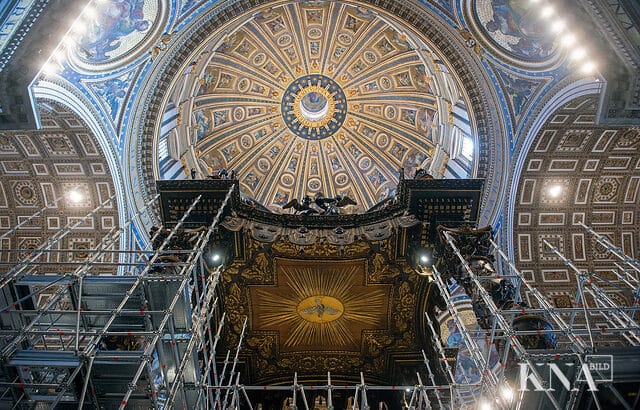Sabine Kleyboldt (KNA)
It took Bernini nine years to create his first work of art in St Peter’s Basilica. It will have taken a good nine months to free the bronze canopy from the dust of the centuries. Then visitors will be rubbing their eyes.
The excitement is growing: the huge grey cuboid in the crossing of St Peter’s Basilica still looks more like a stray flying object or a work by packaging artist Christo. But by Christmas at the latest, the mighty bronze baldachin by Baroque master Gian Lorenzo Bernini should be unveiled in its full splendour; a mere snap of the fingers compared to the nine years it took to create it 400 years ago.
The restoration of the almost 30 metre high and 63 tonne canopy, which crowns the main altar, is one of the major projects for the Holy Year 2025, which Pope Francis intends to open on Christmas Eve. The baroque opus made of bronze, marble, wood and gold has amazed many millions of people since its completion in 1633. The symbolic power of the monument, as tall as a ten-storey building, could hardly be greater: it connects the tomb of the Apostle Peter deep in the Vatican Grottoes with the 117 metre high main dome of the most important church in the world.
Admiration
But in addition to their admiration, the 60,000 or so visitors a day also leave dirt, hair and skin particles in St Peter’s Basilica. Together with dust and oil, all of this has etched itself onto the exceptional work of art and left it tarnished, from the marble plinths to the globe and cross high up on the onion-shaped spire. For the Holy Year, for which more than 32 million guests are expected in Rome, the magnificent work is to shine in its original splendour. The estimated costs of 700,000 euros are being covered by the Knights of Columbus, a conservative US association of Catholics.
Since the spring, scientists from universities and the Vatican Museums have been analysing, photographing, filming and mapping every putti, tassel and statue on the canopy. No one has come this close since the last restoration in 1758. Behind the slightly transparent tarpaulins around the scaffolding, teams of up to 15 restorers and experts are more to be guessed at than seen. The colour of the cladding was chosen because it blends discreetly into the surroundings of the papal basilica, explains Pietro Zander, head of the Vatican’s cathedral construction workshop – as far as a monstrosity that catches the visitor’s eye as soon as they enter the 186-metre-long nave can be discreet.
The four almost life-size angels at the corners of the roof are frozen in dramatic gestures; golden olive and laurel branches climb up the spiral columns”
The construction of the metal scaffolding is also challenging: it encloses the delicate work of art without touching it. In total, almost a kilometre of power cables and water pipes were laid on the floors. The experts are slowly working their way down from the top, equipped with scalpels, iron brushes, micro drills and vibration engravers.
Although the surface is huge – 150 square metres alone are covered in gold – the work is progressing well. Zander is optimistic that it will be completed in time for 24 December. “What’s new is that visitors will then be able to see the two colours for the first time: the gleam of gold and black on the columns and statues.” Very important: “The restorers are not adding anything. We will see the canopy as it was designed by the Baroque artist Bernini.”
Magnificent
In keeping with the style of the time, he did not skimp on magnificent details: the four almost life-size angels at the corners of the roof are frozen in dramatic gestures; golden olive and laurel branches climb up the spiral columns. The marble plinths show the papal crown and the keys of St Peter on the outside, symbolising the papacy. Numerous bees, heraldic animals of the noble Barberini family, are a reminder of the – not uncontroversial – family of the patron, Pope Urban VIII (1623-1644).
“Quod non fecerunt barbari, fecerunt Barberini” (What the barbarians couldn’t do, the Barberini could) is a Roman proverb that alludes to a well-known legend: According to this legend, Urban VIII had tonnes of bronze transported from the roof of the Pantheon to St Peter’s Basilica for his pet project. But Pietro Zander refers to archive documents: “We know that bronze came from the Pantheon for the canopy, but it originally came from the cathedral building workshop in St Peter’s and was returned to the Pope.” In fact, six copper ribs were removed from the dome of St Peter’s Basilica and melted down for the artwork. In any case, there is no truth to the legend of the busy Barberini bees.



